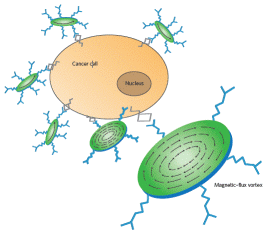Magnet therapy, magnetic therapy, or magnotherapy is an alternative medicine practice involving the use of static magnetic fields. Practitioners claim that subjecting certain parts of the body to magnetostatic fields produced by permanent magnets has beneficial health effects. These pseudoscientific physical and biological claims are unproven and no effects on health or healing have been established. Although hemoglobin, the blood protein that carries oxygen, is weakly diamagnetic (when oxygenated) or paramagnetic (when deoxygenated) the magnets used in magnetic therapy are many orders of magnitude too weak to have any measurable effect on blood flow.
Georges Lakhovsky published books and articles that claimed and attempted to demonstrate that living cells emit and receive electromagnetic radiations at their own high frequencies.
 In 1925 Lakhovsky wrote a Radio News Magazine article entitled "Curing Cancer With Ultra Radio Frequencies." In 1929 while in France he was the author of a book "The Secret of Life: Electricity, Radiation and Your Body" (French) in which he claimed and attempted to demonstrate that good or bad health was determined by the relative health of these cellular oscillations, and bacteria, cancers, and other pathogens corrupted them, causing interference with these oscillations. It was translated to English in 1935. Numerous depictions pictured in the book supposedly have Lakhovsky in a Paris, France hospital conducting clinical research treating cancer patients with before, during, and after photographs.
In 1925 Lakhovsky wrote a Radio News Magazine article entitled "Curing Cancer With Ultra Radio Frequencies." In 1929 while in France he was the author of a book "The Secret of Life: Electricity, Radiation and Your Body" (French) in which he claimed and attempted to demonstrate that good or bad health was determined by the relative health of these cellular oscillations, and bacteria, cancers, and other pathogens corrupted them, causing interference with these oscillations. It was translated to English in 1935. Numerous depictions pictured in the book supposedly have Lakhovsky in a Paris, France hospital conducting clinical research treating cancer patients with before, during, and after photographs.More recently, Dr Elena Rozhlova of Argonne National Laboratory in the United States, says subjecting the nanodiscs to a low magnetic field for around ten minutes was enough to destroy 90% of cancer cells in tests.
The researchers used a culture of glioblastoma multiforme, an aggressive form of brain cancer, to test the nanodiscs, which are made from an iron-nickel alloy. When the nanodiscs were exposed to an alternating magnetic field of between 10 to 20 Hz, it caused them to oscillate, disrupting the membranes of the cancer cells resulting in cell death. The method uses magnetic fields only one tenth the strength of those of used in previous approaches, and at much lower frequencies, avoiding the negative side effects associated with higher-strength fields.
Previous research into the use of magnetic-nanoparticles have required high magnetic fields or resulted in the accumulation of particles due to permanent magnetisation of the particles which form into clumps in the body. The researchers say this new technique offers "exciting avenues for probing cell mechanics... as well as for advancing cancer therapies." In a commentary on the report, Professor Jon Dobson of Keele University in Britain says antibodies could be used to direct the discs towards tumour cells.
Alternatively, a team of University of Texas at Arlington researchers have developed a method that uses magnetic carbon nanoparticles to target and destroy cancer cells through laser therapy - a treatment they believe could be effective in cases of skin and other cancers without damaging surrounding healthy cells.
A paper about the work by Ali R. Koymen, professor of physics, and Samarendra Mohanty, assistant professor of physics, was published in January’s edition of the Journal of Biomedical Optics.
Because these nanoparticles are magnetic, the researchers use an external magnetic field to focus them on the cancer cells. Then, they use a low-power laser to heat them and destroy the cells beneath. Koymen said. “Since only the carbon nanoparticles are affected by the laser, the method leaves the healthy tissue unharmed and it is non-toxic.”
The idea of killing cancer with heat isn't new. Researchers know that, like normal cells, cancer cells start to die when the mercury rises above 43˚C. The trick is figuring out how to kill the cancer without harming the body's own cells. One promising idea, known as magnetic hyperthermia, involves injecting minuscule "nanoparticles," basically microscopic lumps of iron oxide or other compounds, into tumors to make them magnetic. The patient is put into a magnetic field that reverses direction thousands of times every second. The magnetic nanoparticles are excited by the applied field and begin to get hot, heating and potentially destroying the surrounding cancer tissue.
Because healthy tissue is not altered by the magnetic field, it does not heat up and is not damaged. Nano particles are expected to be the next miracle in medical science, the manufacture of magnetic particles requires a broad-range of skills. They include the targeting properties for specific cells. Also creating magnetic particles would cause clumping due to their magnetic properties. The future of nano particles will eventually enable wider applications for MRI enhancement and therapeutic heating for chemotherapy compliment or cell destroying for a tumour. The early days of using magnetic fields,had half the equation of having a positive effect on the human body. Seventy years from Lakhovskys research on magnetic fields, are now agitating particles for heating specific areas turning a pseudoscience in to a real working cure and diagnostic tool...






No comments:
Post a Comment